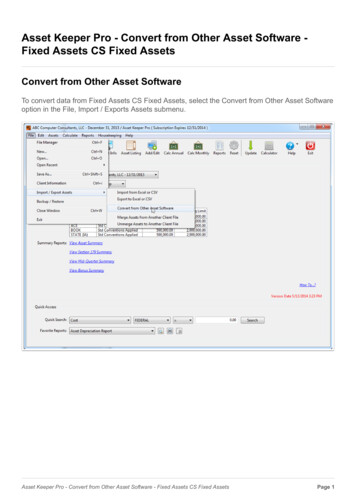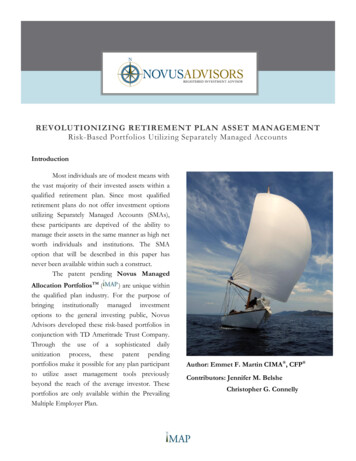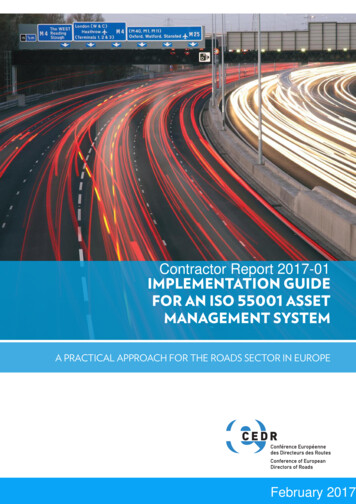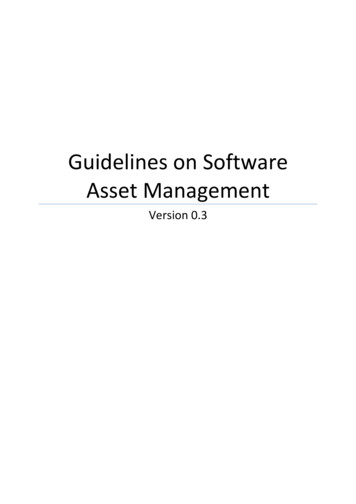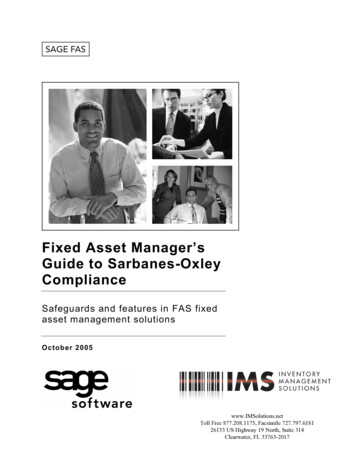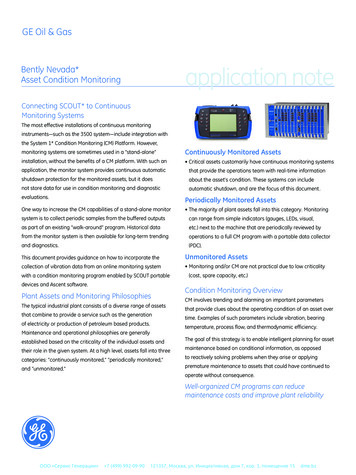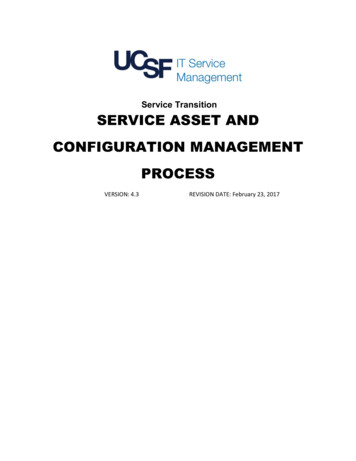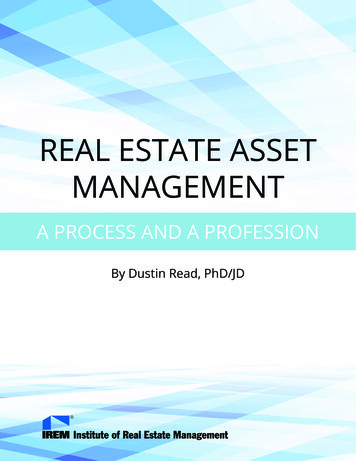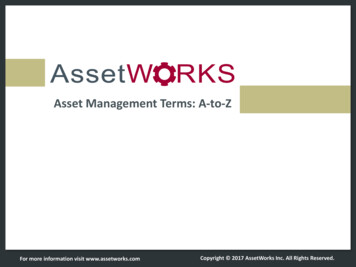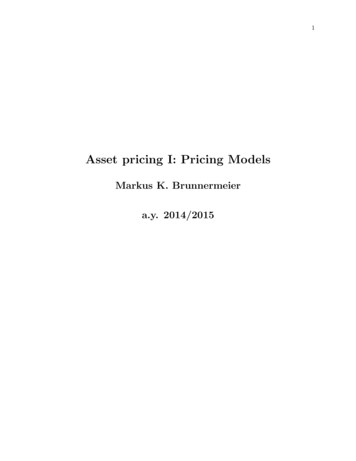
Transcription
1Asset pricing I: Pricing ModelsMarkus K. Brunnermeiera.y. 2014/2015
Contents1Introduction1.18Market Efficiency . . . . . . . . . . . . . . .1.1.1Dividend/Price Ratio and StockPrices . . . . . . . . . . . . . . . . .1.1.21.21.31011Size and Book to Market as driversof Stock Returns . . . . . . . . . . .111.1.3Winners and Losers . . . . . . . . .121.1.4Event Studies. . . . . . . . . . . .131.1.5Government Bonds . . . . . . . . .161.1.6Corporate Bonds . . . . . . . . . .171.1.7Derivatives Pricing . . . . . . . . .18Stocks and Macroeconomic Factors . . . .191.2.1Measuring Risk with Covariance .20The 2013 Nobel Prize in Economics . . . .212
CONTENTS2One Period Model242.1General Security Structure . . . . . . . . .282.2Derivatives292.333. . . . . . . . . . . . . . . . . .2.2.1Forward Contracts. . . . . . . . .292.2.2Options . . . . . . . . . . . . . . . .30Back to Security Structures . . . . . . . .322.3.133Prices . . . . . . . . . . . . . . . . .Pricing in the One Period Model353.1Forwards Revisited . . . . . . . . . . . . . .363.1.1Prepaid Forwards . . . . . . . . . .363.1.2Forwards . . . . . . . . . . . . . . .37Options Revisited . . . . . . . . . . . . . .383.2.1Option Price Boundaries . . . . . .383.2.2Time to Expiration . . . . . . . . .393.2.3Strike Price . . . . . . . . . . . . . .39Back to the One Period Model . . . . . . .403.3.1State Prices . . . . . . . . . . . . . .413.3.2The Fundamental Theorem of Fi-3.23.3nance . . . . . . . . . . . . . . . . .3.3.342State Prices and Incomplete Markets . . . . . . . . . . . . . . . . . .43
CONTENTS3.43.544Asset Pricing Formulas . . . . . . . . . . .443.4.1State Price Model . . . . . . . . . .443.4.2Stochastic Discount Factor . . . . .453.4.3Equivalent Martingale Measure . .463.4.4State-Price Beta Model47. . . . . .Recovering State Prices from Option Prices 48Risk Preferences and Expected Utility Theory554.1State-by-State Dominance . . . . . . . . .554.2Stochastic Dominance . . . . . . . . . . . .574.3Von Neumann Morgenstern Expected Utility Theory . . . . . . . . . . . . . . . . . . .604.4Representation of Preferences . . . . . . .614.5Risk Aversion, Concavity, Certainty Equivalent . . . . . . . . . . . . . . . . . . . . . .644.6Measures of Risk Aversion . . . . . . . . .664.7Risk Aversion and Portfolio Allocation . .684.8Alternative Theories . . . . . . . . . . . . .704.9Savings . . . . . . . . . . . . . . . . . . . . .714.10 Mean-Variance Preferences . . . . . . . . .73
CONTENTS55General Equilibrium, Efficiency and theEquity Premium Puzzle775.1Pareto Efficiency . . . . . . . . . . . . . . .5.2The Sharpe Ratio, Bonds and the EquityPremium Puzzle . . . . . . . . . . . . . . .815.3Adding Expected Utility . . . . . . . . . .835.4The Equity Premium Puzzle . . . . . . . .845.5Empirical Estimation: Generalized Methodof Moments . . . . . . . . . . . . . . . . . .67985Mean-Variance Analysis and CAPM876.1The Traditional Derivation of CAPM . . .886.1.1Two Fund Separation . . . . . . . .956.1.2Equilibrium leads to CAPM . . . .96The Modern Approach . . . . . . . . . . .986.26.2.1Pricing and Expectation Kernel.1026.2.2Beta Pricing . . . . . . . . . . . . .1056.3Testing CAPM . . . . . . . . . . . . . . . .1066.4Practical Issues . . . . . . . . . . . . . . . .1076.4.1Estimating Means . . . . . . . . . .1076.4.2Estimating Variances . . . . . . . .107
CONTENTS66.4.37Estimating Covariances . . . . . . .1086.5Unstable Portfolio Weights . . . . . . . . .1086.6The Black-Litterman Approach . . . . . .1096.6.1109The Black-Litterman Model . . . .The Multi-Period Model7.1Model Setup. . . . . . . . . . . . . . . . .7.2Dynamic Trading and Market Completeness . . . . . . . . . . . . . . . . . . . . . . .7.39115118The Multi-Period Stochastic Discount Factor8114. . . . . . . . . . . . . . . . . . . . . . .1227.4Martingales . . . . . . . . . . . . . . . . . .1247.5Ponzi Schemes and Rational Bubbles . . .126Multi-Period Model: Options1318.1Two-Period Binomial Tree . . . . . . . . .8.2The Relation with the Black-Scholes Model 1348.3Delta-Hedging. . . . . . . . . . . . . . . .1358.4The Volatility Smile . . . . . . . . . . . . .1368.5Collateralized Debt Obligations . . . . . .136Multi-Period Model: Fixed Income9.1Duration . . . . . . . . . . . . . . . . . . . .133138140
CONTENTS79.2The Term Structure of Interest Rates . .1419.3The Expectations Hypothesis . . . . . . .1419.4Futures . . . . . . . . . . . . . . . . . . . . .1439.5Swaps . . . . . . . . . . . . . . . . . . . . . .14510 The Multi-Period Equilibrium Model14910.1 Dynamic Hedging Demand INCOMPLETE 14910.2 Intertemporal CAPM . . . . . . . . . . . .150
Chapter 1IntroductionAsset pricing is the study of the value of claims to uncertain future payments. Two components arekey to value an asset: the timing and the risk of its payments. While time effects are relativelyeasy to explain, corrections for risk are much more important determinants of many assets’ values.For example, over the last 50 years U.S. stocks have given a real return of about 9% on average.Only about 1% of this can be attributed to interest rates; the remaining 8% is a premium earnedfor holding risk.This raises the question: what determines the price of financial claims? That is, why do prices moveover time, and why do different asset have different prices?1 There are several approaches that havebeen used to answer these questions: Statistical approaches look at statistical relationships between asset prices “Weak” economic approaches look at some basic relations that must hold between asset prices,such as the absence of risk-free profitable strategies2 Economic models derive prices from the fundamental characteristics of an economy3Financial claims are promises of payments at various points in the future: for example, a stock isa claim on future dividends; a bond is a claim over coupons and principal; an option is a claimover the future value of another asset. More formally, suppose that we are at date t, then we canwe define payments xt τ for τ 1 and expect the price of these payments to be something likePpt Et[xt τ ], with some adjustment for time and risk. Another way to think about financialτ 1claims is in terms of returns, defined as how much money we make if we hold an asset for a givenamount of time: Rt 1 two assets i and j:eRt 1pt 1 xt 1pt 1 1. We call excess return the difference between the returns of Ri,t 1 Rj,t 1 . We can interpret these three representations as follows:1We will see that these questions refer to “time-series” and “cross-sectional” problems, respectively.This concept is referred to as “no arbitrage”.3Such as preferences, technology, etc.28
CHAPTER 1. INTRODUCTION9we can invest pt today and get {xt τ } in the future, or invest 1 unit today and get Rt 1 in theefuture, or yet invest 0 units today and get Rt 1in the future. What are the properties of returns?Can we predict when assets will have high or low returns? Can we predict which assets have higheror lower returns? Historically, there have been two schools of thought on this subject: The old view (1970s): Expected returns do not move much over time: stocks returns areunpredictable because prices move with news about future cash-flows. The “classic” model forasset pricing, called CAPM, works pretty well: returns with high covariance with the marketreturn have are higher on average as predicted by the mdoel. The beta parameter in theCAPM model derives from the covariance between asset cash-flows and market cash-flows. The modern view: Expected returns move a lot over time: stock returns are predictable.Prices move with news about changes in the discount rate used by people to discount assets.We can understand the cross-sectional relation between asset prices with multi-factor models:characteristics other than the beta are associated with returns, and non-market betas mattera lot. Finally, betas derive from the covariance between discount rates and market discountrates.Asset pricing theory can be used to describe both the way the world works and the way the worldshould work. Once we observe the prices, we can use asset pricing theory to understand why pricesare what they are, and modify our theory if the predictions are not consistent with the observations;or we can decide that the observed prices are wrong, or mispriced, and take advantage of the tradeopportunity. Much of asset pricing theory stems from one simple concept:Price equals expected discounted payoffThe rest is elaboration, special cases and a few tricks. There are two approaches to this elaboration,called absolute asset pricing and relative asset pricing . In absolute asset pricing we priceeach asset by reference to its exposure to fundamental macroeconomic risk.4 This approach ismost popular in many academic settings in which we use asset pricing to give an explanation forwhy prices are what they are in order to predict how prices might change if policy or economicstructure changed. In relative pricing we infer an asset’s value given the prices of some other asset.Black-Scholes option pricing is the classic example of this approach.The central and unfinished task of asset pricing theory is to understand and measure the sources ofaggregate risk that drive asset prices. Of course, this is also the central question of macroeconomics,and in fact a lot of empirical work has documented stylized facts and links between macroeconomicsand finance. For example, expected returns vary across time and across assets in ways that are linkedto macroeconomic variables: we have learned that the risk premium on stocks5 is much larger than4The classic examples of this approach are the Walrasian general equilibrium model discussed in Léon Walras’“Elements Of Pure Economics” (1877), and Gerard Debreu’s “Theory of Value” (1959).5The difference between the stock return and the risk-free interest rate.
CHAPTER 1. INTRODUCTION10the interest rate, and varies a lot more than interest rates. This means that attempts to line upinvestments with interest rates are vain, as much of the variation in cost of capital comes fromthe varying risk premium. Similarly, we have learned that some measure of risk aversion mustbe quite high, or people would all borrow like crazy to buy stocks. Moreover, while standardmacroeconomics theory predicts that agents do not care about business cycles,6 asset prices revealthat they do: agents forgo substantial return premia to avoid assets whose value falls in recessions.And yet theory still lags behind: we do not yet have a well-described model that fully explains thesecorrelations.The rest of these notes is organized as follows. We start with frictionless markets and minimalassumptions, adding more structure as the course progresses to obtain more and deeper implications.In the second part of the course we will extend the discussion to multi-period settings, and finallyconclude by studying financial markets with frictions.1.1Market EfficiencyWhen is an asset fairly valued? We cannot answer this question without referring to a specificmodel or assumption about the asset. Consider for instance the following assumption:Prices incorporate and reflect all publicly available informationA direct consequence of this hypothesis is that stock returns should be unpredictable: for example,when new information is released, stock prices should jump to the new fair level and then keeptrading around it. Are these features observed in reality? We will address this question with thenext subsections.A related famous assumption is the Random Walk hypothesis, which states that stock market pricesevolve according to a random walk, and therefore cannot be predicted. This is compatible with theEfficient Markets hypothesis outlined before, and it implies that stock price movements can only beattributed to 1) news on future corporate cash flows, 2) changes in “risk premia” - the amount ofextra return that investors demand to hold risk (we will come back to this in the next lectures) or3) shifts in behavioral bias.Testing these hypotheses can be done in one of two main ways. One approach is to look at crosssectional data, that is, data collected at the same point in time, or regardless of differences in time.Studies that use this approach look at whether some factors can explain the stock price changes,potentially in contradiction to the efficient markets or random walk hypothesis. Another approach isto look at time-series data, that is, data collected as a sequence of data points. Time-series studieslook into the existence of trends, seasonalities, or event-specific behaviors that would invalidate theefficient markets or random walk hypothesis.6Lucas (1987).
CHAPTER 1. INTRODUCTION1.1.111Dividend/Price Ratio and Stock PricesA consequence of the efficient markets hypothesis is that the Dividend/Price (D/P) ratio shouldbe a good indicator of future dividend movements, because when the dividend is expected to go upthe price also goes up (since it gives right to more cash flows), thus decreasing the D/P ratio untilthe moment when the dividend is declared. After that moment, the ratio goes back to its previouslevel.7 However, it turns out that the D/P ratio is much better at predicting future stock pricemovements than dividend movements: a simple regression of the S&P 500 index price growth onthe D/P ratio shows that the latter is a good predictor of future price growth.1.1.2Size and Book to Market as drivers of Stock ReturnsAverage monthly stock returns appear to be higher the smaller the company size as measured byits assets, and the higher its Book-to-Market, that is, the more a company is perceived as a “value”company by the market (as opposed to “growth” stocks).7Because the dividend will either be increased, as the market predicts, thus increasing the D/P ratio; or it will notbe increased, and consequently the stock price will decrease to the level it was at before the expectation was formedand thus increasing the D/P ra
a claim on future dividends; a bond is a claim over coupons and principal; an option is a claim over the future value of another asset. More formally, suppose that we are at date t, then we can we de ne payments x t for 1 and expect the price of these payments to be something like p t ˇE t P 1 [x t ], with some adjustment for time .
